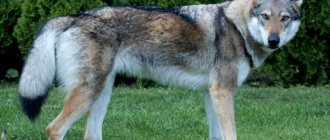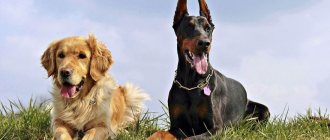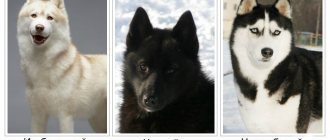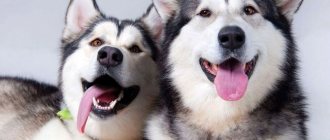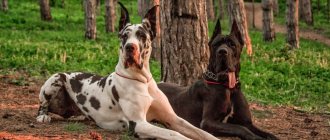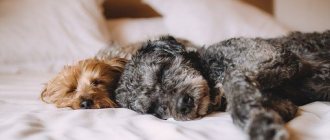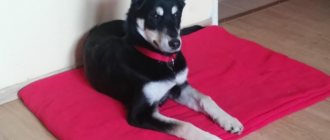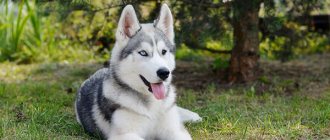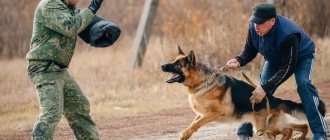To a person who is far from dog breeding, huskies and malamutes look almost like twins: both of these dogs seem equally large and fluffy to him.
But, despite some external similarities, as well as a common original purpose, the husky and malamute have quite a lot of differences.
The difference between these dogs becomes especially noticeable when they are side by side, for example, in the show ring.
And then even a non-specialist becomes clear that these are representatives of two different breeds.
A little about malamutes
Description and what they look like in the photo
The Alaskan Malamute is a fairly large northern sled dog of the aboriginal type, distinguished by a strong physique and well-developed muscles .
Its coat is two-layered, consisting of a soft undercoat and coarse, denser guard hair.
Colors vary from grayish to black, and reddish or sable coat color is also acceptable. At the same time, the Malamute necessarily has the so-called undercolor - lightening to white on the belly, chest, neck, head, hind legs and tail. Of the single-color colors, only white is considered acceptable.
Other characteristics of the appearance of Malamutes:
- The body of Malamutes is only slightly stretched: their body length should exceed the height at the withers by no more than 2 cm.
- The head is wide and quite massive, but at the same time commensurate with the body and paws.
- The limbs are strong and powerful, always parallel and well muscled.
- The tail is not too long, moderately pubescent and usually carried over the back in the form of a plume.
- Malamutes have medium-sized ears, erect, triangular. Set relatively wide and low, which gives the dog's muzzle a good-natured and calm expression.
- The eyes are small, almond-shaped, slightly slanted. Only brown eye color is allowed; blue iris or heterochromia are disqualifying defects.
When evaluating a dog at an exhibition, the proportionality of the build and the productivity of the gait are of greater importance than individual parameters.
Advantages and disadvantages
Pros:
- They are distinguished by strength and endurance.
- Smart and smart.
- Friendly to people.
- Affectionate and obedient.
- Loyal to children.
- They tolerate loneliness quite well: they do not howl when left alone in the house and do not cause damage to the interior.
- Beautiful and stately.
- Can be used as a sled dog or sport dog.
Minuses:
- They show aggression towards small animals.
- They have a tendency to dig up the earth.
- They shed heavily.
- They don't make very good watchmen.
- They need a lot of physical activity.
Character
The Alaskan Malamute is a friendly, loyal and affectionate dog . He treats all family members equally well and willingly looks after the children, patiently enduring all their pranks.
But at the same time, the Malamute does not like to be pestered too much: calm and friendly by nature, it can show dissatisfaction if it is teased or offended.
Outwardly, such a dog looks large and powerful, but due to its innate good nature and the good attitude developed over the centuries towards all people without exception, it is not suitable for the role of guard of a house or apartment..
Malamutes are strong and strong animals that, while usually obedient and friendly, can sometimes be stubborn and self-willed.
These dogs are characterized by intelligence and intelligence, thanks to which they were able to survive in the harsh climatic conditions of Alaska.
Northern sled breeds
As noted above, this breed is considered one of the oldest in North America. The teachings state that it is Malamutes who live most with the company of people.
We invite you to familiarize yourself with: Siberian Husky breed standard
The DNA of Alaskan Malamutes is close to that of the wolf. Such data became known after special research.
It is also believed that these dogs came to North America along with nomadic tribes that came from the eastern region of Siberia approximately 14 thousand years ago.
It is worth noting that the DNA is similar between the following breeds: Alaskan Malamute, Siberian Husky, Alaskan Klee Kai. With the help of photographs of the Alaskan Malamute, you can clearly evaluate how this breed differs from others similar to it.
Alaskan Malamutes are large and strong dogs. They have great endurance and strength. Their maximum height at the withers reaches 64 centimeters, and their weight reaches 34 kilograms. Such parameters are typical for male dogs.
The maximum height of the bitches is 58 centimeters, weight – 34 kilograms. However, as an exception, smaller and larger individuals are found.
Size is not as important when assessing a dog as its proportionality, agility and activity.
Representatives of this breed have a large head, proportional to the size of the body. If you look at the muzzle from the front, its shape should visually resemble that of a wolf. The eye shape is almond-shaped, the size is medium. Normal eye color is brown.
The ears are triangular in shape with rounded tips. They are spaced widely on the head.
Alaskan Malamutes have a thick, double coat. This “fur coat” allows dogs to feel great even in the harshest winter.
During the summer, dogs shed heavily and their coat becomes thinner. This breed has several colors: gray, black and white.
Another breed that belongs to the northern sled dogs is the Samoyed (Samoyed dog). And despite the fact that all three of these breeds belong to the same group, their purposes are still different.
Huskies were used to transport small loads, but the Malamute was a heavyweight dog that transported impressive loads over long distances. Samoyeds were helpers of shepherds, defended houses from wolves, and sometimes carried small luggage.
Hence the differences in the character of these breeds. Husky is the most independent dog of the three, and Malamute always strives for leadership, which is why it is much more difficult to raise him. But the Samoyed is a wonderful companion dog that can also be an excellent nanny for children.
Husky, Malamute, Samoyed are the most popular, but far from the only breeds related to northern sled dogs. There are about ten of them in total - this is not counting the aboriginal breeds that are not recognized by the International Canine Federation. All these dogs are united by physical endurance, unpretentiousness, a strong constitution and a calm, balanced character. Northern sled dogs were used to transport people or goods on sleds over snow or ice.
All sled breeds are different, but what they have in common is that they all help a person survive in the most difficult conditions of the far north, becoming not only an indispensable assistant, but also a faithful, loving friend.
Briefly about huskies
Description
The Siberian Husky is a northern sled dog of medium height , fast and agile, in which endurance and running speed are successfully combined with harmony and some grace of physique .
Males of this breed look more courageous: they have stronger bones and better developed muscles. But more feminine and graceful females should also not appear too delicate or weak.
Regardless of gender, the husky has a compact body with well-developed and strong muscles.:
- The head should not be coarse and massive, nor too light. The transition to a moderately wide muzzle is well defined, but not abrupt.
- The ears are medium in size, triangular in shape, erect and set high.
- The eyes are almond-shaped, moderately widely spaced, blue or brown. Heterochromia is also allowed.
- The limbs are moderately wide, straight and parallel, with well-developed muscles.
- The tail resembles a fox's in shape and size. When calm, it is lowered and straightened; when alert, it rises above the back and is carried in the shape of a sickle.
- The coat consists of a soft and warm undercoat, as well as a short, smooth-lying awn.
Huskies can have any color, from white to black , and often have a light mask of a characteristic shape on the head .
Show huskies are somewhat different from working and sporting dogs: they look more impressive, but at the same time, due to their shortened muzzle, they are not so hardy.
Advantages and disadvantages
Pros:
- They are smart and know how to make their own decisions.
- Beautiful and charming: huskies have expressive eyes and rich facial expressions.
- They do not show aggression towards strangers.
- They treat children well.
- They love to follow their owner everywhere.
Minuses:
- Not suitable for protection.
- They love to dig the ground and create tunnels.
- Wouldn't mind hunting birds or, for example, cats.
- They can be stubborn and self-willed.
- Prone to escape.
- Left alone, they often howl out of boredom, chew furniture or tear off wallpaper.
Huskies love to be busy and it doesn’t matter to them whether it’s a show career, sports, or just long walks in the company of their beloved owner.
Character
Huskies are friendly and affectionate, but at the same time somewhat independent . These dogs are vigilant and careful, however, due to their lack of a protective instinct, they are too trusting and make poor watchdogs.
This dog is excellent at adapting to different conditions, he is neat and clean.
Self-sufficient and independent, reminiscent of a cat in character, he has a tendency to run away and walk on his own, and therefore needs careful supervision, especially if he lives in a rural area.
The Husky is best suited for sports and carrying light loads than for any other work.
What are the differences?
Malamutes are large and broad-boned, they look more massive than the fit and lighter Huskies.
The height at the withers of a husky is 52-55 cm at the withers with a weight of 20-30 kg, while for a malamute it is 60-65 cm with a body weight of 32-43 kg.
The Malamute's head is noticeably larger, more massive and wider.
Its ears are slightly rounded at the ends and set wide apart, whereas the Husky's ears are pointed and set quite close.
The Malamute's eyes are almond-shaped, with a friendly and calm expression . Husky eyes are medium in size, with slightly raised corners, and their gaze is attentive, and sometimes even stern.
NOTE!
If in a husky both blue and dark eyes and even heterochromia are considered acceptable, then in a malamute the eyes should only be brown.
The Malamute's nose is larger in size and usually black. A husky's nose is smaller and may have darker pigmentation on the sides than in the center.
The Malamute's tail is carried at the level of the back and looks like a plume . A husky's tail hangs down when at rest and only when it is interested it rises above its back in the shape of a sickle.
In addition, the Malamute has strong and powerful paws, while the Husky looks taller and its paws are not too large in size.
The color of the Malamute is most often black or grayish, although it can be red, sable with undergrowth, and pure white. A husky's coat color can be any color.
The Malamute's coat is longer, but coarser, while the Husky's is shorter, softer and smoother..
By nature, the Malamute is calm and balanced, while the Husky is temperamental, cunning and stubborn. And, if strength and power are felt in the movements of the Malamute, then the gait of the Husky is fast and energetic.
Huskies have a habit of howling, while Malamutes do this extremely rarely..
What is the difference between a husky and a malamute?
- Malamutes from Alaska are broad-boned in appearance and look more massive, larger than the light, fit Siberian Huskies.
- Huskies have attentive eyes, often with a stern look, while Malamutes have a calm and friendly look.
- Malamutes are calmer in character and much more loyal to their owner.
- Another interesting difference between them is that they have a very shaggy tail, which they hold around their muzzle, which helps protect their nostrils from snow.
- Huskies have a soft outer coat, while Malamutes have a rough, two-layer coat with an undercoat.
- The Malamute's tail is worn at the level of the back, while the Husky's tail is often lowered, only when alert, raised like a sickle over the back.
Alaskan Malamute - description of the breed
A large breed with well-developed muscles. The color can be white or with shades of gray and black. Interestingly, there is always lightening in the chest, abdomen, head, neck, and tail. The almond-shaped eyes are exclusively brown in color.
Siberian Husky description
The breed is of medium height with a compact body and well-developed muscles. The tail looks like a fox's. They come in any color, including white and black. It is distinguished by a characteristic light mask on its head. The eyes are blue, but can also be brown, with a very expressive look, they even have rich facial expressions.
For what purposes are they intended?
- Malamutes are adapted for transporting heavy loads over short distances. Breeding location: Alaska.
- Husky - for transporting small loads over long distances at great speed in Siberia.
An excellent comparison comes to mind: Huskies rush like “fast cavalry”, and Malamutes move like “heavy artillery”.
Character traits
Malamute. Quite a reserved dog, balanced. He will never be the first to disturb the owner, pester him, and at the same time does not hide his delight and pleasure from communication. We train well. In relation to other dogs he is dominant, towards strangers he is calm as long as he is not disturbed. They tolerate loneliness well; they do not howl when left in the house.
Husky. Playful by nature, energetic, cunning, affectionate, loves kids. Very “clingy” to his owner. Suitable for mobile, active people. It has disadvantages: wayward ambition, if it doesn’t work up, it can run away. Sheds a lot. They cannot stand loneliness, they chew furniture and wallpaper, and howl from boredom.
Are they suitable for protection?
Husky is unlikely to make a good watchdog, because dogs are kind, and they treat everyone indiscriminately.
Malamutes are completely non-aggressive dogs and practically do not bark. Instead of barking, they can produce sounds of a kind of “grumbling”, inherited from distant “relatives” - wild wolves.
| Alaskan Malamute | Siberian Husky | Samoyed | |
| Purpose | Transporting heavy loads at low speed over long distances. | Transportation of light loads over long distances at considerable speed. | Sled dog, companion dog. |
| General form | A powerful, athletically built dog, with a deep chest and well-developed muscles. The Malamute stands firmly on its feet and gives the impression of a very energetic dog with its head held high. | A working dog of medium size, with a fast and light gait, with free and elegant movements. Balance of strength, speed and endurance. A certain reserve of restraint and dignity may be evident in an adult dog. | Medium sized, elegant, white Arctic Spitz. In appearance one can feel power, endurance, charm, softness, dignity and self-confidence. Gender must be clearly expressed. |
| Scull | Wide | Medium width | Wide |
| Facial expression | Soft, friendly, shows affection and affection, lively interest and curiosity are visible in the eyes. | Sharp, sometimes angry, wary, cunning and mischievous, interested. (the author of the definition is Polina Panyukova) | The expression of a teddy bear (for the Finnish line) or a wolf (for the American breeding line) with the so-called “Samoyed smile” due to the combination of the shape of the eyes, their location and the slightly upward-curving corners of the mouth. |
| Bridge of the nose, stop (transition from forehead to muzzle) | Slightly deviating from a straight line | Well expressed | Well expressed |
| Muzzle | Large, voluminous | Conical | Conical |
| Lips | Tightly compressed | Closely squeezed | Rounded, not drooping to the corners |
| Ears | Medium size, small in relation to the head | Medium, thick, well pubescent | Medium, thick, well pubescent |
| Ear fit | Widely spaced on the outside of the skull | Set high, pointed straight up | Wide apart, but within the border of the outer edge of the skull |
| Eyes | Oval, obliquely set, brown. Blue eyes or eyes of different colors are not allowed. | Oval, obliquely set. The eyes may be brown or blue; divergence of eyes and partial coloring are acceptable. | Oval, inclined upward, dark brown in color. Blue eyes or eyes of different colors are not allowed. |
| Nose, pigmentation | Snow nose is acceptable, brown for red dogs, black for all others | Snow nose is acceptable, pink in white dogs, liver in red dogs, black in all others | Black is preferred, but other colors are not penalized. |
| Bite | Scissor-shaped, large teeth | Scissor-shaped | Scissor-shaped, strong teeth |
| Neck | Strong and curved | Medium and curved | Strong, well muscled |
| Ribs | Well developed chest and ribs | Quite elastic, not barrel-shaped | Sufficiently elastic |
| Topline | The back is straight, slightly inclined towards the hips | One level from withers to croup | The withers are the highest, the back is level with the lower back, the loin is slightly arched, the croup is slightly sloping |
| Tail | A swinging “fan” over the back, not grasping and not tightly twisted into a ring. Can be pulled back while moving. | A round panicle above the back (“fox tail”), when moving it is directed upward or curved. with a sickle, in a stance below the level of the back. | Richly covered with long hair, carried over the back or side. In a calm state it can be lowered. |
| Height at withers | Ideal: male – 63.5 cm, female – 58.5 cm, natural deviation is allowed. No extreme growth limits have been established. | Males: 53.5 – 60 cm. Females: 50.5 – 56 cm. Dimensions represent the extreme limits of growth. | The ideal height for males is 57 cm ± 3 cm and for females – 53 cm ± 3 cm. |
| Weight | Ideal: male – 38 kg, female – 34 kg, natural deviation is allowed (weight is proportional to height). No extreme limits have been set. Massive bones are welcome, but without excess weight. | Extreme growth limits - males: 20.5 - 28 kg, females: 15.5 - 23 kg. Any manifestations of excessive bonyness or weight are punished. | From 23 to 30 kg. Weight in proportion to height |
| Proportions | slightly stretched (optimal ratio of height at withers to body length is 9/10) | stretched | Almost square (body length approximately 5% greater than height at withers) |
| Bones | massive | average | Massive for the size |
| Pasterns/tarsus | Short, strong, slightly sloping | Strong, slightly inclined, flexible | Strong, straight but flexible |
| Paws | Large, snowshoes, compact, thick pads, fur between the toes | Medium size, oval, compact, thick pads, fur between toes | Large, long, almost flat, thick pads, feathering on legs |
| Stifles (back leg angles) | Moderate angulation, slightly flexed, metatarsus straight down | Well defined corners, located close to the ground | Well defined, 30% of the height from the hip |
| Wool | Double, “standing”: (1) dense, oily, woolly undercoat, similar to felt, (2) coarse protective coat (awn), harsher than that of a husky. | Double, soft and dense undercoat, protective coat straight and smoothly lying, never standing. | Double: soft thick undercoat, coarse standing protective coat |
| Color | From light gray to black, can also be sable, red, brown and white. The only solid color is white | The color of the Siberian Husky can be almost any color. All colors are allowed from black and brown to pure white | White, cream or white and biscuit (primary color is white with some biscuit markings). Should not give the impression of being pale brown. |
You will also be interested in The largest and largest diamonds in the world with photos (top 10)
How are the breeds similar?
- Both are considered quite hardy and frost-resistant, as they were bred in a difficult climate in the treacherous northern conditions.
- These dogs are the most reliable companions. They lack causeless aggression by nature. There have been isolated cases in practice due to the fault of the person himself.
- Both breeds are endowed with the highest intelligence, are easy to train, and get along well with kids. In different situations they are able to make decisions independently.
- They are friendly towards other animals; general hostility is expressed only towards cats.
- Coat care requires special attention, periodically brushing, and during the shedding season this should be done daily.
- They are endowed with an instinct for hunting, as they are considered a hunting breed.
- At the same time, they love affection and wait for it.
- Must receive daily exercise: 1-2 hours a day, 3 times the most active walks. Otherwise, energy will accumulate and flow out in an undesirable way.
How long do they live?
Smaller Huskies live for about 12-14 years, and slightly larger Malamutes live up to 15 years.
Haskomut or Aluskys cross
If you cross both breeds with each other, you get the most wonderful creation - Haskomut or Aluskys. The dog is ideal if the breeder does not have the goal of visiting various exhibitions. The mixed breed will combine the best character traits of its parents: the phlegmatic Malamute will be diluted by the tireless husky. The crossed dog will be an ideal friend for a family with children. Professional racers use this breed most often.
How are they similar?
Both dogs were bred in the North, and therefore both Huskies and Malamutes are perfectly adapted to harsh climatic conditions and are particularly resilient and frost-resistant.
Over centuries of close interaction with people, representatives of both breeds have learned to trust unconditionally and have a habit of becoming strongly attached to their owners..
Both of these dogs are smart and can make their own decisions when necessary.
They both have triangular erect ears, a long fluffy tail and a two-layer coat, which is most often grayish or reddish-brown, which is mainly due to the external similarity of these breeds.
Both Malamutes and Huskies were bred as sled dogs, but if the duty of the former was to transport heavy loads, then Huskies were valued for their speed in delivering goods..
External differences
The Malamute is another northern sled dog breed. Outwardly, they are very similar to huge wolves, but have a good-natured and affectionate character. Unlike graceful huskies, malamutes have a massive, heavy structure, thanks to which they are able to pull sleds with a large load. These dogs work well in a team, but have strong leadership qualities.
If he recognizes his owner as a leader, he will faithfully serve him all his life. Compared to the lively nature of Huskies, Malamutes are calmer and more balanced. Another interesting character trait common to both Malamutes and Huskies is their dislike for cats. You shouldn’t try to make them friends with small dogs either.
Both breeds are highly intelligent. But to succeed, the dog handler needs to interest and captivate the dog. In addition to excellent working qualities, huskies can make good guard dogs, while malamutes are absolutely non-aggressive and affectionate with all people. An important difference between Malamutes and other dogs is the absence of barking; they only sometimes “mutter.” This feature remained from their ancestors - wolves.
Many people believe that huskies and huskies are the same thing. This idea is completely wrong. First of all, because the husky is a sled working breed, and the husky is a hunting breed. Laika is a northern representative of the Spitz class. From their famous ancestors, dogs received protruding ears and a fluffy tail, beautifully curved in a ring. Laikas have strongly expressed hunting qualities, and slightly less guard qualities. The dogs have a friendly and affectionate character.
To choose the right dog, you need to decide for what purpose it is needed. If you are choosing a dog for sporting competitions, then the best choice would be an Alaskan husky. Malamutes and huskies are ideal for harness work. But, more often than not, when choosing a dog, we choose a pet and a friend. In order for the years of life together to bring only joy, you need to be prepared for the manifestations of certain aspects of character inherent in a particular breed.
For example, a husky feels better in a group of dogs. They have a lot of energy and if the dog has nowhere to spend it, the active mind begins to come up with activities that usually do not please the owner. Huskies need to be given a lot of time, walked a lot, and allowed to run without a leash. If a dog runs around in the yard, then the area should be surrounded by a high fence, dug deep into the ground.
If there are no athletes in the family who can wear out active huskies, then it is better to choose a calmer Malamute. They get along well with people and children. The downside of this breed is that they are difficult to train. But once you communicate with a Malamute, it is impossible not to fall in love with this kind, grumbling wolf.
Among the huskies, you can choose a snow-white Samoyed, a very affectionate Yakut husky, or the largest representative of this species - the East Siberian husky. All types of huskies have good hunting qualities and are easily trained for a certain type of prey. With some likes, people also go after bears.
Malamutes and huskies are becoming increasingly popular among dog lovers around the world.
Both breeds are considered irreplaceable helpers and loyal friends of humans.
They become strongly attached to their owner, affectionate and devoted.
Both Malamutes and Huskies were bred in the north, and were used primarily for sled riding.
The historical homeland of the first breed is Alaska, and the second is Siberia.
These dogs are distinguished by high endurance and the ability to tolerate low temperatures well.
The debate about which dog breed is better has been going on for a long time, but it is still a very subjective question.
The best physical abilities are noted in the husky, but the speed qualities are noted in the husky.
So, let’s look at how huskies and malamutes differ from each other.
Here is a comparison of the physical abilities and temperament of the Husky Malamute breeds:
- Hunting skills. Both dogs know how to hunt and are distinguished by their keen eyesight, good scent and endurance.
- Ride quality. Huskies and Malamutes are bred specifically for sled riding. Compared to its brother, the Malamute can pull heavier loads over longer distances. Its running speed is not high, unlike its ability to carry a small load quite quickly. Huskies are lighter dogs that often take part in speed competitions.
- Character. Malamutes and huskies behave completely differently. The former are distinguished by a calmer character and friendly attitude. The latter, on the contrary, are cunning, curious and temperamental. Husky will find a common language with children. These dogs love to play and never show unmotivated aggression towards both humans and other animals. Malamutes will not take care of babies and babysit them, but they will become a loyal friend to their owner.
They are naturally able to find themselves in the wild forest. However, they will not give their prey to a person, and they will not bring back a shot animal.
We invite you to read: Siberian Husky - description of the dog breed from A to Z
Huskies are very vocal and loud dogs, while Malamutes, on the contrary, are silent, they almost never bark.
Many people confuse these two breeds with each other.
The difference in appearance, at first glance, may not seem too obvious.
Let's figure out what differences are present in dogs of these breeds.
External differences of dogs:
- General Appearance: The Alaskan stands out compared to his fast friend due to his more powerful and athletic build. Husky is slightly smaller in size - it is a medium-sized breed. His movements are lighter and more elegant.
- Height at the withers: Huskies average 53 to 56 cm, which is 10-12 cm less than a Malamute.
- Weight: Malamutes are heavier on average by 10-12 kilograms. The weight of both breeds is proportional to their height. However, Huskies are prone to overeating and obesity, which is not observed in the Alaskan brother.
- Coat: Coarser, stiffer and standier in the Malamute. Huskies are characterized by having a double, soft and smooth coat.
- Color: almost any color is allowed for the Siberian representative (from black to snow-white). But a Malamute can have a light gray, black, red sable, brown and white coat. The only solid color can be white. Its main difference is the characteristic mask on its face.
- Eyes: Huskies are famous for their bottomless blue eyes. Very rarely there are individuals with brown and multi-colored eyes. But the Malamute’s eyes are effectively outlined with a black edging and their color, in most cases, is brown.
- Tail: not too curled and carried upward in Alaskans. Siberians are distinguished by a fluffy, curled, down-turned tail that looks like a fox's.
This description should help you distinguish between the Malamute Husky breeds.
When crossing dogs, they often end up with the appearance of a husky and the character of a malamute.
Such offspring are considered outbred and are not intended for further breeding.
Although the cubs born from such a marriage are very cute, smart and good-natured.
Malamutes, huskies and their crosses are northern dogs with excellent working qualities and good character. At first glance, they are very similar to each other, but at the same time completely different.
Due to the fact that the “first” breed was crossed with local representatives of dogs, both in Siberia and Alaska their appearance is slightly different. Externally, Malamutes are taller than Siberians. Their dimensions can reach 64 cm, while “Siberians” do not exceed 56 cm. The big difference lies in weight, dogs from Alaska weigh 39 kg, and from the north of Russia - no more than 28-30 kg. It should be said about the wool cover.
Malamutes have significantly longer hair than Huskies, giving them a fuller appearance. The massive wool allows them to withstand extremely low temperatures, which are unbearable even for Siberians. But such a “fur coat” greatly reduces the speed of the Malamute compared to the Siberian. The large size of the Alaskan dog makes it more agile, capable of transporting large loads, but this also affects its endurance; the Siberian dog is able to cover a much greater distance than the Malamute without stopping for a break.
If it is necessary to cover a distance of up to 12-15 km, as a competition, then the difference between the breeds is almost imperceptible: where there is a straight and well-trodden path, the Siberian dog will dominate; on deep and snowy trails, the malamute will take the lead due to its strength, weight and height. That is why they are allowed to participate in the races without classification.
Outwardly, in detail, it is clear how dogs from Alaska and Siberia differ, but the differences also lie in the character of the animals.
Both huskies and malamutes are completely devoted to their owner and there is no difference in this. Their different personalities are immediately evident in terms of training. Alaskan dogs are calmer and “softer”. The Malamute instantly learns new commands and is able to act in accordance with any instructions from a person.
We invite you to read: The cat does not eat or drink, he is vomiting, we eliminate the cause and not the symptoms
Malmut is extremely obedient and gets along well with children. The Siberian dog is a Klondike of energy and loud bark. The dog is also very friendly and gets along with any other animals, but training “Siberians” is a real test. Husky does not listen, during the training process he instantly loses interest in everything that is happening, and suffers from absent-mindedness. The animal just needs to run constantly.
Which breed is best suited for living in an apartment?
The Malamute has a calmer disposition and does not tend to misbehave when left alone all day.
Huskies can also be kept in the city, but it must be taken into account that these dogs are prone to mischief out of boredom and if the owner does not want to return home to find chewed furniture or wallpaper torn from the walls, he should take care of purchasing a cage for the pet.
Huskies often howl when left alone, and therefore the owner will have to make a lot of effort to wean them from this bad habit..
Expert opinion
Kozhevin Semyon Kirillovich
Expert dog handler.
“Malamute and husky may seem the same only at first glance. Despite the fact that both of these dogs are northern sled breeds, they have much more differences than similarities. Malamutes are calmer and even phlegmatic, while huskies are emotional and very active. It is impossible to immediately say which of them is better and which one should be started. The future owner, when choosing a pet breed, must decide who is more suitable for him in temperament and character: a calm malamute or a temperamental husky.”
Education and training
Malamutes and huskies have different levels of intelligence. The differences lie not in which dog is smarter, but in the choice of training methods. Those who believe that huskies are poorly trainable dogs are completely wrong. They need to start training from early childhood, and the main principle in this work should be the dog’s interest in learning. Circus training is contraindicated for this breed.
Raising a Malamute must begin from the moment the puppy appears in the house. At the same time, be sure to take into account the two main character traits of your pet - the desire for leadership and stubbornness. There is one more feature of the Malamute that you need to pay attention to when raising a puppy - this handsome guy has a passion for digging the earth. If you value order in your garden, train your Malamute to dig in one specific place.
We have presented you with two similar dog breeds - Malamute and Husky. The differences between them, as you can see, are quite obvious. We hope that now you can independently distinguish a purebred puppy from a crossbreed.
Who is easier to maintain and care for?
Both Huskies and Malamutes require occasional brushing and infrequent bathing. They will also need to have their eyes and ears cleaned from time to time, and their nails trimmed if necessary.
It should be taken into account that representatives of both breeds shed heavily, and therefore during the shedding season the pet will have to be combed not a couple of times a week, as usual, but daily.
Attitude towards children and pets
Huskies have an active and playful disposition; they are better suited for playing with older children. Malamutes treat children quite well, but rather in a protective manner than in a friendly manner.
As for the attitude towards other pets, the Malamute, being a natural leader, strives to dominate other dogs.
In addition, he may not be too kind to cats, rodents and other smaller pets.
However, a husky, due to its hunting instincts, may try to hunt other domestic animals or birds.
Whichever of these two breeds the dog is, in any case it needs early socialization and proper upbringing.
Comparison by other criteria
Life expectancy and health
The life expectancy of Huskies is, on average, 12-14 years, and for Malamutes it reaches 13-15 years.
Both breeds enjoy good health, but may be susceptible to eye problems, musculoskeletal disorders, and diabetes..
Huskies that participate in sports may also develop respiratory problems.
Due to the fact that Malamutes and Huskies have such a good appetite and are always ready to eat at any opportunity, they are susceptible to obesity and related diseases.
Aggressiveness towards strangers
Neither malamutes nor huskies have it naturally.
Obedience
The Malamute is more obedient and less likely to be stubborn and willful than the Husky..
On the other hand, he needs a strong and self-confident owner, since otherwise he simply will not be able to prove to the dog his physical and moral superiority.
Character traits
Malamute and husky differ not only in appearance. They have different characters. Husky is very affectionate and friendly, but not without self-esteem. If you have a hyperactive child, then you should get a husky. Be sure that your child will make friends with the new family member. You can't find a better partner for active games than a husky.
This dog never shows unmotivated aggression towards humans or other animals. Many owners note that these animals are too independent, which often interferes with training.
Alaskan Malamutes are often called “intellectuals.” Looking at his pet, the owner is able to determine his mood by the expression of his “face”. This powerful handsome man will always find a common language with children. It is unlikely that he can become a caring nanny, but he will certainly be a loyal friend. The Malamute is a very silent person - he barks very rarely. This dog makes sounds that are very similar to grumbling.
Which breed should you choose?
Huskies can be recommended as a pet to active people involved in sports or to families with older children: such a dog will become a good companion while jogging, as well as an excellent playmate.
If the future owner does not like noise and fuss, then it is better for him to choose a calmer and more balanced Malamute.
When choosing between representatives of these two breeds, you need to remember that both huskies and malamutes are sled dogs that require a lot of physical activity.
So what are the differences between a Malamute and a Husky?
- The speed of their movement, the Malamute is many times slower than the Husky, which makes it impossible to participate in any sled competitions.
- The Malamute is stronger and more resilient, but still weighs under 70 kg. doesn't let you forget about yourself.
- Huskies are more active and kind, you need to constantly play with them. Dl
The human heart cannot be indifferent to huskies, malamutes, and Samoyeds. Indeed, the luxury of these breeds is unparalleled. The husky's blue eyes alone seem to reflect the entire blue of the sky. The feeling of falling in love is born immediately; it is not for nothing that photographs of these breeds receive the most sympathy from viewers. Massive, luxurious snow dogs are very similar in appearance. Without knowing the characteristics of the breeds, they can easily be confused. Although it’s unlikely that anyone will be particularly upset, because the rocks are simply a real snow miracle.
Despite their similarity, huskies and malamutes differ not only in appearance. Dogs were bred in different places, with different selection biases, and have their own character. Some people mistake these two different breeds not just for one, but also classify them as huskies. No, huskies and malamutes are different classes of breeds. While the latter were bred as sled dogs, the Laika is a purely hunting dog.
